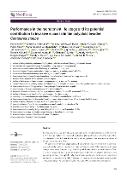| dc.contributor.author | Kožić, Kevin | |
| dc.contributor.author | Hartmann, Matthias | |
| dc.contributor.author | Callaway, Ragan Morrison | |
| dc.contributor.author | Hensen, Isabell | |
| dc.contributor.author | Nagy, Dávid U. | |
| dc.contributor.author | Mráz, Patrik | |
| dc.contributor.author | Al-Gharaibeh, Mohammad M. | |
| dc.contributor.author | Bancheva, Svetlana | |
| dc.contributor.author | Diaconu, Alecu | |
| dc.contributor.author | Danihelka, Jiří | |
| dc.contributor.author | Ensing, David J. | |
| dc.contributor.author | Filep, Rita | |
| dc.contributor.author | Gudžinskas, Zigmantas | |
| dc.contributor.author | Hajdari, Avni | |
| dc.contributor.author | Nicoară, Roxana | |
| dc.contributor.author | Lachmuth, Susanne | |
| dc.contributor.author | Moffat, Chandra E. | |
| dc.contributor.author | Novikov, Andriy | |
| dc.contributor.author | Purger, Dragica | |
| dc.contributor.author | Slate, Mandy L. | |
| dc.contributor.author | Synowiec, Agnieszka | |
| dc.contributor.author | Vonica, Ghizela Daniela | |
| dc.contributor.author | Zuleger, Annika Mikaela | |
| dc.contributor.author | Rosche, Christoph | |
| dc.date.accessioned | 2025-01-13T14:10:56Z | |
| dc.date.available | 2025-01-13T14:10:56Z | |
| dc.date.issued | 2024 | |
| dc.identifier.uri | https://hdl.handle.net/20.500.14178/2807 | |
| dc.description.abstract | The recruitment life stage, including germination and early seedling establishment, is the most vulnerable life stage of plants and has cascading effects on plant performance at later life stages. However, surprisingly little is known on the eco-evolutionary processes that determine the success of biological invasions at this life stage. We performed germination experiments with and without simulated drought stress and monitored early seedling growth in diploid and tetraploid Centaurea stoebe. . While diploids are the major cytotype in the native European range, only tetraploids became invasive in North America. Thus, C. stoebe is an excellent model species to simultaneously study both, pre-adaptive differences in the native range (diploids vs. tetraploids) and post-introduction evolution in the non-native range (native tetraploids vs. non-native tetraploids). To account for broad spatial-environmental variation within cytotypes and ranges, we germinated 23,928 seeds from 208 widely distributed populations.Tetraploids germinated better than diploids. Within tetraploids, invasive populations outperformed native populations in germination. However, these differences were not evident under simulated drought stress. Seedlings of invasive tetraploids had a higher biomass and developed the first true leaf earlier than those from the native range, while the native cytotypes did not differ in these early seedling traits. Our results suggest that a combination of pre-adaptation related to superior performance of polyploids (greater and faster germination) and post-introduction evolution towards higher performance in the invasive range (greater and faster germination, greater and faster accumulation of seedling biomass) may have contributed to the invasion success of tetraploid C. stoebe in North America. | en |
| dc.language.iso | en | |
| dc.relation.url | https://doi.org/10.3897/neobiota.95.127654 | |
| dc.rights | Creative Commons Uveďte původ 4.0 International | cs |
| dc.rights | Creative Commons Attribution 4.0 International | en |
| dc.title | Performance in the recruitment life stage and its potential contribution to invasive success in the polyploid invader Centaurea stoebe | en |
| dcterms.accessRights | openAccess | |
| dcterms.license | https://creativecommons.org/licenses/by/4.0/legalcode | |
| dc.date.updated | 2025-01-13T14:10:56Z | |
| dc.subject.keyword | biological invasions | en |
| dc.subject.keyword | Cox-regression | en |
| dc.subject.keyword | geo-cytotypes | en |
| dc.subject.keyword | germination | en |
| dc.subject.keyword | pre-adaptation | en |
| dc.subject.keyword | post-introduction evolution | en |
| dc.subject.keyword | seedling establishment traits | en |
| dc.subject.keyword | spotted knapweed | en |
| dc.identifier.eissn | 1314-2488 | |
| dc.relation.fundingReference | info:eu-repo/grantAgreement/UK/COOP/COOP | |
| dc.relation.fundingReference | info:eu-repo/grantAgreement/UK/PROGRES/Q43 | |
| dc.date.embargoStartDate | 2025-01-13 | |
| dc.type.obd | 73 | |
| dc.type.version | info:eu-repo/semantics/publishedVersion | |
| dc.identifier.doi | 10.3897/neobiota.95.127654 | |
| dc.identifier.utWos | 001336390700006 | |
| dc.identifier.eidScopus | 2-s2.0-85206839483 | |
| dc.identifier.obd | 657590 | |
| dc.subject.rivPrimary | 10000::10600::10611 | |
| dc.subject.rivSecondary | 10000::10600::10618 | |
| dcterms.isPartOf.name | NeoBiota | |
| dcterms.isPartOf.issn | 1619-0033 | |
| dcterms.isPartOf.journalYear | 2024 | |
| dcterms.isPartOf.journalVolume | 95 | |
| dcterms.isPartOf.journalIssue | 17.10.2024 | |
| uk.faculty.primaryId | 115 | |
| uk.faculty.primaryName | Přírodovědecká fakulta | cs |
| uk.faculty.primaryName | Faculty of Science | en |
| uk.department.primaryId | 1032 | |
| uk.department.primaryName | Katedra botaniky | cs |
| uk.department.primaryName | Department of Botany | en |
| uk.department.secondaryId | 2025 | |
| uk.department.secondaryName | Herbářové sbírky | cs |
| uk.department.secondaryName | Herbarium | en |
| dc.description.pageRange | 309-329 | |
| dc.type.obdHierarchyCs | ČLÁNEK V ČASOPISU::článek v časopisu::původní článek | cs |
| dc.type.obdHierarchyEn | JOURNAL ARTICLE::journal article::original article | en |
| dc.type.obdHierarchyCode | 73::152::206 | en |
| uk.displayTitle | Performance in the recruitment life stage and its potential contribution to invasive success in the polyploid invader <em>Centaurea stoebe</em> | en |

